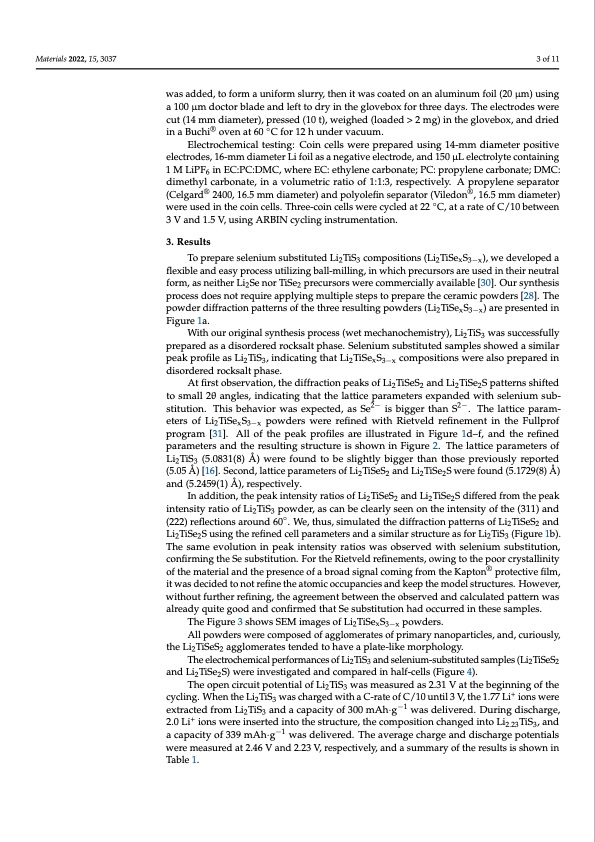
PDF Publication Title:
Text from PDF Page: 003
Materials 2022, 15, 3037 3 of 11 was added, to form a uniform slurry, then it was coated on an aluminum foil (20 μm) using a 100 μm doctor blade and left to dry in the glovebox for three days. The electrodes were cut (14 mm diameter), pressed (10 t), weighed (loaded > 2 mg) in the glovebox, and dried in a Buchi® oven at 60 ◦C for 12 h under vacuum. Electrochemical testing: Coin cells were prepared using 14-mm diameter positive electrodes, 16-mm diameter Li foil as a negative electrode, and 150 μL electrolyte containing 1 M LiPF6 in EC:PC:DMC, where EC: ethylene carbonate; PC: propylene carbonate; DMC: dimethyl carbonate, in a volumetric ratio of 1:1:3, respectively. A propylene separator (Celgard® 2400, 16.5 mm diameter) and polyolefin separator (Viledon®, 16.5 mm diameter) were used in the coin cells. Three-coin cells were cycled at 22 ◦C, at a rate of C/10 between 3 V and 1.5 V, using ARBIN cycling instrumentation. 3. Results To prepare selenium substituted Li2TiS3 compositions (Li2TiSexS3−x), we developed a flexible and easy process utilizing ball-milling, in which precursors are used in their neutral form, as neither Li2Se nor TiSe2 precursors were commercially available [30]. Our synthesis process does not require applying multiple steps to prepare the ceramic powders [28]. The powder diffraction patterns of the three resulting powders (Li2TiSexS3−x) are presented in Figure 1a. With our original synthesis process (wet mechanochemistry), Li2TiS3 was successfully prepared as a disordered rocksalt phase. Selenium substituted samples showed a similar peak profile as Li2TiS3, indicating that Li2TiSexS3−x compositions were also prepared in disordered rocksalt phase. At first observation, the diffraction peaks of Li2TiSeS2 and Li2TiSe2S patterns shifted to small 2θ angles, indicating that the lattice parameters expanded with selenium sub- stitution. This behavior was expected, as Se2− is bigger than S2−. The lattice param- eters of Li2TiSexS3−x powders were refined with Rietveld refinement in the Fullprof program [31]. All of the peak profiles are illustrated in Figure 1d–f, and the refined parameters and the resulting structure is shown in Figure 2. The lattice parameters of Li2TiS3 (5.0831(8) Å) were found to be slightly bigger than those previously reported (5.05 Å) [16]. Second, lattice parameters of Li2TiSeS2 and Li2TiSe2S were found (5.1729(8) Å) and (5.2459(1) Å), respectively. In addition, the peak intensity ratios of Li2TiSeS2 and Li2TiSe2S differed from the peak intensity ratio of Li2TiS3 powder, as can be clearly seen on the intensity of the (311) and (222) reflections around 60◦. We, thus, simulated the diffraction patterns of Li2TiSeS2 and Li2TiSe2S using the refined cell parameters and a similar structure as for Li2TiS3 (Figure 1b). The same evolution in peak intensity ratios was observed with selenium substitution, confirming the Se substitution. For the Rietveld refinements, owing to the poor crystallinity of the material and the presence of a broad signal coming from the Kapton® protective film, it was decided to not refine the atomic occupancies and keep the model structures. However, without further refining, the agreement between the observed and calculated pattern was already quite good and confirmed that Se substitution had occurred in these samples. The Figure 3 shows SEM images of Li2TiSexS3−x powders. All powders were composed of agglomerates of primary nanoparticles, and, curiously, the Li2TiSeS2 agglomerates tended to have a plate-like morphology. The electrochemical performances of Li2TiS3 and selenium-substituted samples (Li2TiSeS2 and Li2TiSe2S) were investigated and compared in half-cells (Figure 4). The open circuit potential of Li2TiS3 was measured as 2.31 V at the beginning of the cycling. When the Li2TiS3 was charged with a C-rate of C/10 until 3 V, the 1.77 Li+ ions were extracted from Li2TiS3 and a capacity of 300 mAh·g−1 was delivered. During discharge, 2.0 Li+ ions were inserted into the structure, the composition changed into Li2.23TiS3, and a capacity of 339 mAh·g−1 was delivered. The average charge and discharge potentials were measured at 2.46 V and 2.23 V, respectively, and a summary of the results is shown in Table 1.PDF Image | Lithium-Rich Rock Salt Type Sulfides-Selenides

PDF Search Title:
Lithium-Rich Rock Salt Type Sulfides-SelenidesOriginal File Name Searched:
materials-15-03037-v2.pdfDIY PDF Search: Google It | Yahoo | Bing
Product and Development Focus for Salgenx
Redox Flow Battery Technology: With the advent of the new USA tax credits for producing and selling batteries ($35/kW) we are focussing on a simple flow battery using shipping containers as the modular electrolyte storage units with tax credits up to $140,000 per system. Our main focus is on the salt battery. This battery can be used for both thermal and electrical storage applications. We call it the Cogeneration Battery or Cogen Battery. One project is converting salt (brine) based water conditioners to simultaneously produce power. In addition, there are many opportunities to extract Lithium from brine (salt lakes, groundwater, and producer water).Salt water or brine are huge sources for lithium. Most of the worlds lithium is acquired from a brine source. It's even in seawater in a low concentration. Brine is also a byproduct of huge powerplants, which can now use that as an electrolyte and a huge flow battery (which allows storage at the source).We welcome any business and equipment inquiries, as well as licensing our flow battery manufacturing.| CONTACT TEL: 608-238-6001 Email: greg@salgenx.com | RSS | AMP |